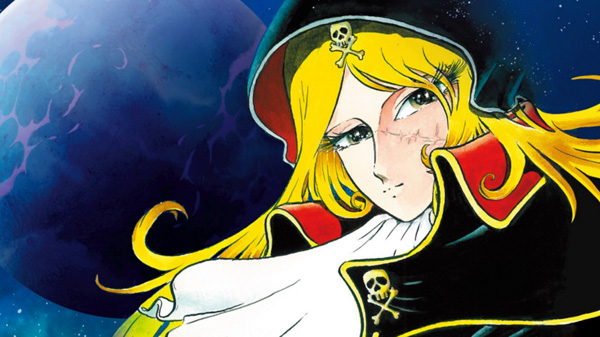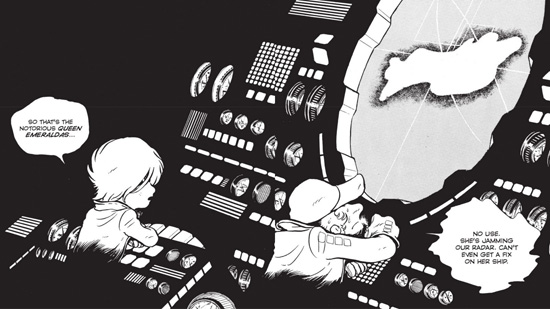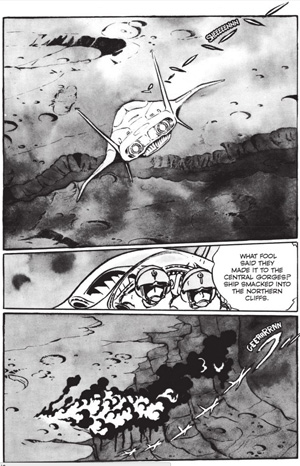 ©Leiji Matsumoto/Kodansha, Ltd. All rights reserved.
©Leiji Matsumoto/Kodansha, Ltd. All rights reserved.By my count, it’s been almost 15 years since we got any English-translated manga from sci-fi master Leiji Matsumoto (that being Galaxy Express 999 in 2002). This despite his mentor, Osamu Tezuka, getting attention in the US manga industry for over a decade now and Matsumoto’s own prodigious influence on American anime fandom via the 1974 anime Space Battleship Yamato, aka Star Blazers. Thankfully, Kodansha Comics has given Matsumoto another shot in the US, though 1978’s Queen Emeraldas seems a strange title to start with.
Despite appearing in many of Matsumoto’s most famous works, including Galaxy Express and Captain Harlock, Emeraldas is far from his most recognizable hero. In fact, she is more often used as connective tissue, bringing some semblance of continuity to the notoriously flimsy “Leijiverse” (there’s no strict canon in Matsumoto’s work, but characters often cameo in each other’s stories). She is consistently depicted as a tough, independent space pirate, and in this version she drifts through space, occasionally and mysteriously coming to the aid of struggling spaceship engineer Hiroshi Umino as he attempts to build a ship and begin his life among the stars.
 ©Leiji Matsumoto/Kodansha, Ltd. All rights reserved.
©Leiji Matsumoto/Kodansha, Ltd. All rights reserved.The manga narrative is similarly aimless; the series meanders between vignettes focusing on Umino, Emeraldas, or both, and covers both the present day and the past. In the first volume Umino builds (and crashes) a few ships, traveling the galaxy as he goes, and we learn some of the details about Emeraldas’ backstory, including how she acquired her massive space blimp, the titular “Queen Emeraldas.” More importantly, however, the vignettes paint a portrait of a stark, nihilistic future, a universe in which the fierce individualism of the Wild West meets the vast loneliness of outer space. That grit mixed with  Matsumoto’s trademark melodrama lends a lot of emotional weight to each of Umino and Emeraldas’ encounters.
Matsumoto’s trademark melodrama lends a lot of emotional weight to each of Umino and Emeraldas’ encounters.
Since Matsumoto is most famous in the States for anime adaptations of his work, most fans associate him with his one-of-a-kind character designs, but Emeraldas showcases a remarkable talent for composition, with jagged, dynamic panels and sweeping, detailed spreads clearly inspired by but sometimes even more daring than Tezuka’s. In manga form, Matsumoto’s designs are more than just dashing pretty boys and slender women—they transform in close-up shots into incredibly emotive expressionist collages. Looking at Queen Emeraldas, it’s no surprise that Matsumoto worked in shojo manga before moving to space operas.
Volume 1 of the series doesn’t reveal much about its enigmatic heroine, but Leiji Matsumoto is one of the most famous anime/manga artists in history for good reason. Queen Emeraldas is both a fascinating historical time capsule and an excellent read on its own merits. Recommended.
publisher: Kodansha Comics
story and art: Leiji Matsumoto
rating: 13+


![Yokohama Station SF [Manga Review] Yokohama Station SF [Manga Review]](https://otakuusamagazine.com/wp-content/uploads/2023/11/Yokohama-Station-SF-v2-crop2-480x360.jpg)
![Manner of Death [Review] Manner of Death [Review]](https://otakuusamagazine.com/wp-content/uploads/2023/10/manner-of-death-v2-crop-480x360.jpg)
![Origin [Review] Origin [Review]](https://otakuusamagazine.com/wp-content/uploads/2023/10/origin-10-crop-480x360.jpg)
![Lady Oscar: The Rose of Versailles [Anime Review] Lady Oscar: The Rose of Versailles [Anime Review]](https://otakuusamagazine.com/wp-content/uploads/2021/11/RoV_Vol2_Front_CoverArt_V1-480x360.jpg)

![Kirby Manga Mania [Manga Review] Kirby Manga Mania [Manga Review]](https://otakuusamagazine.com/wp-content/uploads/2021/07/kirby-manga-mania-v1-16-9-480x360.jpg)